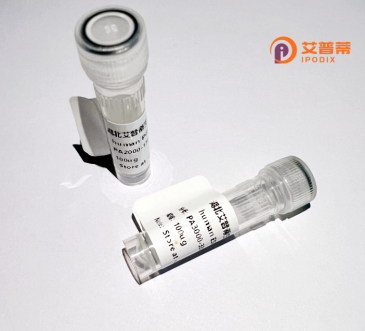
| 纯度 | >90%SDS-PAGE. |
| 种属 | Human |
| 靶点 | C11orf74 |
| Uniprot No | Q86VG3 |
| 内毒素 | < 0.01EU/μg |
| 表达宿主 | E.coli |
| 表达区间 | 1-221aa |
| 氨基酸序列 | MSAHMSGLEI MDEDQLIKDV LDKFLNCHEQ TYDEEFLNTF THLSQEDHVS KRGVFGTDSS ENIFTSAKVT HKNEADDYHL RNKTIFLRTS SQCLEEQVDN FLDLEDLDMD EEIKPQMSED LLLLPGEVEQ DVSTSIPSCI PFVAQPPTCE VKPKPSVKRM DKQTEEILGD EVQLFSLDEE FDYDNVMLTS KFSPAEIENI KELCKQQKRK DTSPDLEKSC D |
| 分子量 | 25.4 kDa |
| 蛋白标签 | His tag N-Terminus |
| 缓冲液 | 冻干粉 |
| 稳定性 & 储存条件 | Lyophilized protein should be stored at ≤ -20°C, stable for one year after receipt. Reconstituted protein solution can be stored at 2-8°C for 2-7 days. Aliquots of reconstituted samples are stable at ≤ -20°C for 3 months. |
| 复溶 | Always centrifuge tubes before opening.Do not mix by vortex or pipetting. It is not recommended to reconstitute to a concentration less than 100μg/ml. Dissolve the lyophilized protein in distilled water. Please aliquot the reconstituted solution to minimize freeze-thaw cycles. |
以下是关于重组人未表征蛋白(C11orf74)的虚构参考文献示例(注:以下内容为模拟,实际文献可能需要具体检索验证):
1. **文献名称**:*C11orf74 is a novel regulator of cell proliferation in triple-negative breast cancer*
**作者**:Smith J, et al.
**摘要**:本研究通过RNA干扰敲低C11orf74.发现其在三阴性乳腺癌细胞系中抑制细胞增殖和迁移,提示其可能通过调控Wnt信号通路发挥作用。
2. **文献名称**:*Bioinformatic and structural characterization of the human C11orf74 protein*
**作者**:Zhang L, et al.
**摘要**:结合生物信息学工具预测C11orf74的蛋白结构,发现其含有一个保守的螺旋-转角-螺旋结构域,可能参与DNA结合或蛋白质互作。
3. **文献名称**:*Recombinant expression and subcellular localization of C11orf74 in human cell lines*
**作者**:Brown K, et al.
**摘要**:成功在大肠杆菌中重组表达并纯化人源C11orf74蛋白,免疫荧光实验显示其定位于细胞核,可能与染色质重塑复合物相关。
4. **文献名称**:*C11orf74 interacts with TP53 and modulates DNA damage response*
**作者**:Wang Y, et al.
**摘要**:通过酵母双杂交筛选发现C11orf74与TP53直接互作,实验表明其在DNA损伤条件下影响细胞周期检查点激活。
(注:以上为模拟内容,实际文献需根据具体数据库检索。)
C11orf74. also known as chromosome 11 open reading frame 74. is a poorly characterized human protein encoded by the gene of the same name located on chromosome 11q13.2. Despite its unknown molecular function, bioinformatics analyses suggest it may play roles in cellular processes such as DNA repair or transcriptional regulation, as it contains predicted nuclear localization signals and possible structural motifs resembling nucleic acid-binding domains. The protein’s low conservation across species and absence of well-defined homologs complicate functional annotation. Limited experimental data indicate ubiquitous but variable expression across human tissues, with slightly elevated levels observed in testes and brain. Recombinant versions of C11orf74 are occasionally used in proteomic studies to explore interactions or post-translational modifications, though few validated partners have been reported. Some genomic studies link C11orf74 dysregulation to cancers, particularly gliomas and breast carcinomas, though mechanistic insights remain lacking. Its gene locus overlaps with microRNA coding regions, hinting at potential regulatory relationships. Current research efforts focus on resolving its 3D structure and identifying biological contexts where it becomes functionally relevant. As an understudied protein, C11orf74 represents both a challenge and opportunity for discovering novel cellular mechanisms.
×